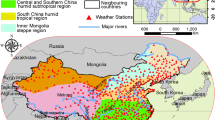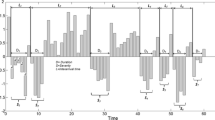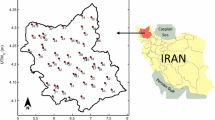Abstract
This study aims to model the joint probability distribution of periodic hydrologic data using meta-elliptical copulas. Monthly precipitation data from a gauging station (410120) in Texas, US, was used to illustrate parameter estimation and goodness-of-fit for univariate drought distributions using chi-square test, Kolmogorov–Smirnov test, Cramer-von Mises statistic, Anderson-Darling statistic, modified weighted Watson statistic, and Liao and Shimokawa statistic. Pearson’s classical correlation coefficient r n , Spearman’s ρ n, Kendall’s τ, Chi-Plots, and K-Plots were employed to assess the dependence of drought variables. Several meta-elliptical copulas and Gumbel-Hougaard, Ali-Mikhail-Haq, Frank and Clayton copulas were tested to determine the best-fit copula. Based on the root mean square error and the Akaike information criterion, meta-Gaussian and t copulas gave a better fit. A bootstrap version based on Rosenblatt’s transformation was employed to test the goodness-of-fit for meta-Gaussian and t copulas. It was found that none of meta-Gaussian and t copulas considered could be rejected at the given significance level. The meta-Gaussian copula was employed to model the dependence, and these results were found satisfactory.









Similar content being viewed by others
References
Akaike H (1974) A new look at the statistical model identification. IEEE Trans Autom Control AC 19(6):716–722
Amal SH (2006) Goodness-of-fit for the generalized exponential distribution. http://interstat.statjournals.net/YEAR/2005/articles/0507001.pdf
Bárdossy A (2006) Copula-based geostatistical models for groundwater quality parameters. Water Resour Res 42:W11416. doi:10.1029/2005WR004754
Bárdossy A, Li J (2008) Geostatistical interpolation using copulas. Water Resour Res 44:W07412. doi:10.1029/2007WR006115
Cancelliere A, Salas JD (2004) Drought length properties for periodic-stochastic hydrologic data. Water Resour Res 40:W02503. doi:10.1029/2002WR001750
De Michele C, Salvadori G (2003) A generalized Pareto intensity-duration model of storm rainfall exploiting 2-copulas. J Geophys Res 108(D2):4067. doi:10.1029/2002JD002534
De Michele C, Salvadori G, Canossi M, Petaccia A, Rosso R (2005) Bivariate statistical approach to check adequacy of dam spillway. J Hydrol Eng 10(1):50–57
Dobrić J, Schmid F (2007) A goodness of fit test for copulas based on Rosenblatt’s transformation. Comput Stat Data Anal 51:4633–4642
Dupuis DJ (2007) Using copulas in hydrology: benefits, cautions, and issues. J Hydrol Eng 12(4):381–393
Evin G, Favre AC (2008) A new rainfall model based on the Neyman–Scott process using cubic copulas. Water Resour Res 44:W03433. doi:10.1029/2007WR006054
Fang HB, Fang KT (2002) The meta-elliptical distributions with given marginals. J Multivar Anal 82:1–16
Favre AC, El Adlouni S, Perreault L, Thiémonge N, Bobeé B (2004) Multivariate hydrological frequency analysis using copulas. Water Resour Res 40:W01101. doi:10.1029/2003WR002456
Fisher NI, Switzer P (1985) Chi-plots for assessing dependence. Biometrika 72(2):253–265
Fisher NI, Switzer P (2001) Graphical assessment of dependence: Is a picture worth 100 tests? Am Stat 55(3):233–239
Gebremichael M, Krajewski WF (2007) Application of copulas to modeling temporal sampling errors in satellite-derived rainfall estimates. J Hydrol Eng 12(4):404–408
Genest C, Boies JC (2003) Detecting dependence with Kendall plots. Am Stat 57(4):275–284
Genest C, Favre AC (2007) Everything you always wanted to know about copula modeling but were afraid to ask. J Hydrol Eng 12(4):347–368
Genest C, Favre AC, Béliveau J, Jacques C (2007a) Meta-elliptical copulas and their use in frequency analysis of multivariate hydrological data. Water Resour Res 43:W09401. doi:10.1029/2006WR005275
Genest C, Rémillard B, Beaudoin D (2007b) Goodness-of-fit tests for copulas: a review and a power study, insurance: mathematics and economics. doi:10.1016/j.insmatheco.2007.10.005
González J, Valdés JB (2003) Bivariate drought recurrence analysis using tree ring reconstructions. J Hydrol Eng 8(5):247–258
Grimaldi S, Serinaldi F (2006a) Asymmetric copula in multi-variate flood frequency analysis. Adv Water Resour 29(8):1155–1167
Grimaldi S, Serinaldi F (2006b) Design hyetograph analysis with 3-copula function. J Hydrol Sci 51(2):223–238
Jackson BB (1975) Markov mixture models for drought lengths. Water Resour Res 11(1):64–74
Kao SC, Govindaraju RS (2007a) A bivariate rainfall frequency analysis of extreme rainfall with implications for design. J Geophys Res 112:D13119. doi:10.1029/2007JD008522
Kao SC, Govindaraju RS (2007b) Probabilistic structure of storm surface runoff considering the dependence between average intensity and storm duration of rainfall events. Water Resour Res 43:W06410. doi:10.1029/2006WR005564
Kao SC, Govindaraju RS (2008) Trivariate statistical analysis of extreme rainfall events via the Plackett family of copulas. Water Resour Res 44(2):W02415. doi:10.1029/2007WR006261
Kim TW, Valdés JB, Yoo C (2003) Nonparametric approach for estimating return periods of droughts in arid regions. J Hydrol Eng 8(5):237–246
Kim TW, Valdés JB, Yoo C (2006) Nonparametric approach for bivariate drought characterization using palmer drought index. J Hydrol Eng 11(2):134–143
Kotz S, Nadarajah S (2001) Some extremal type elliptical distributions. Stat Probab Lett 54:171–182
Kuhn G, Khan S, Ganguly AR, Branstetter M (2007) Geospatial–temporal dependence among weekly precipitation extremes with applications to observations and climate model simulations in South America. Adv Water Resour 30(12):2401–2423
Lane WL (1979) Applied stochastic techniques (LAST last computer package): user manual, division of planning technical services. USBR, Denver
Loáiciga HA (2005) On the probability of droughts: the compound renewal model. Water Resour Res 41:W01009. doi:10.1029/2004WR003075
Mathier L, Perreault L, Bobe B, Ashkar F (1992) The use of geometric and gamma-related distributions for frequency analysis of water deficit. Stoch Hydrol Hydraul 6(4):239–254
Mishra AK, Singh VP, Desai VR (2008) Drought characterization: a probabilistic approach. Stoch Environ Res Risk Assess. doi:10.1007/s00477-007-0194-2
Nadarajah S (2006) Fisher information for the elliptically symmetric Pearson distributions. Appl Math Comput 178:195–206
Nadarajah S (2007) A bivariate gamma model for drought. Water Resour Res 43:W08501. doi:10.1029/2006WR005641
Nadarajah S, Kotz S (2005) Information matrices for some elliptically symmetric distribution. SORT 29(1):43–56
Poulin A, Huard D, Favre AC, Stéphane P (2007) Importance of tail dependence in bivariate frequency analysis. J Hydrol Eng 12(4):394–403
Renard B, Lang M (2007) Use of a Gaussian copula for multivariate extreme value analysis: some case studies in hydrology. Adv Water Resour 30:897–912
Salvadori G, De Michele C (2004) Frequency analysis via copulas: theoretical aspects and applications to hydrological events. Water Resour Res 40:W12511. doi:10.1029/2004WR003133
Salvadori G, De Michele C (2006) Statistical characterization of temporal structure of storms. Adv Water Resour 29(6):827–842
Salvadori G, De Michele C (2007) On the use of copulas in hydrology: theory and practice. J Hydrol Eng 12(4):369–380
Salvadori G, De Michele C, Kottegoda NT, Rosso R (2007) Extremes in nature: an approach using copulas. Water Science and Technology Library Series, vol 56, Springer
Sen Z (1976) Wet and dry periods of annual flows series. J Hydraul Div 102(10):1503–1514
Sen Z (1977) Run-sums of annual flow series. J Hydrol 35(3/4):311–324
Serinaldi F, Grimaldi S (2007) Fully nested 3-copula: procedure and application on hydrological data. J Hydrol Eng 12(4):420–430
Shiau JT (2003) Return period of bivariate distributed hydrological events. Stoch Environ Res Risk A 17(1/2):42–57
Shiau JT (2006) Fitting drought duration and severity with two-dimensional copulas. Water Resour Manag 20:795–815
Shiau JT, Shen HW (2001) Recurrence analysis of hydrologic droughts of differing severity. J Water Resour Plann Manag 127(1):30–40
Shiau JT, Feng S, Nadarajah S (2007) Assessment of hydrological droughts for the Yellow River, China, using copulas. Hydrol Process 21(16):2157–2163
Sklar A (1959) Fonctions de repartition án dimensions et leurs marges. **Publications Institut de Statistique de Université de Paris 8:229–231
Srinivas VV, Srinivasan K (2000) Post-blackening approach for modeling dependent annual streamflows. J Hydrol 230:86–126
Villarini F, Serinaldi G, Krajewski WF (2008) Modeling radar-rainfall estimation uncertainties using parametric and non-parametric approaches. Adv Water Resour 31(2):1674–1686
Wong G, Lambert MF, Metcalfe AV (2007) Trivariate copulas for characterisation of droughts. ANZIAM J 49:C306–C323
Yevjevich V (1967) An objective approach to definitions and investigations of continental hydrologic droughts: hydrology paper 23. Colorado State University, Fort Collins
Zhang G (2000) Multiple complex gauss-Legendre integral formulae and application. J Lanzhou University (Nat Sci) 36(5):30–34
Zhang L, Singh VP (2006) Bivariate flood frequency analysis using the copula method. J Hydrol Eng 11(2):150–164
Zhang L, Singh VP (2007a) Gumbel-Hougaard copula for trivariate rainfall frequency analysis. J Hydrol Eng 12(4):409–419
Zhang L, Singh VP (2007b) Bivariate rainfall frequency distributions using Archimedean copulas. J Hydrol 332:93–109
Zhang L, Singh VP (2007c) Trivariate flood frequency analysis using the Gumbel–Hougaard copula. J Hydrol Eng 12(4):431–439
Acknowledgments
This work was financially supported by the National Science Council, Republic of China (Grant No. NSC-50579065 and NSC-50879070). The authors appreciate Dr. Mehmet Ozger for supplying data.
Author information
Authors and Affiliations
Corresponding author
Appendices
Appendix 1: p-dimensional symmetric elliptical type distributions
A p-dimensional random vector Z is said to have an elliptically contoured distribution (or simply called elliptical distribution or ECD) with parameters μ(p × 1) and ∑(p × p) if it has the stochastic representation (Fang and Fang 2002):
where r ≥ 0 is a random variable, u is uniformly distributed on the unit sphere in R p and is independent of r, A is a p × p constant matrix such that AA T = ∑ and the sign \( \mathop = \limits^{d} \) means that both sides of the equality have the same distribution. In particular, if r has a density, then the density of Z is of the form
where g(·) is a scale function uniquely determined by the distribution of r and is referred to as the density generator. Common p-dimensional symmetric elliptical type distributions are given in Table 1.We use the notation Z ~ EC p (μ, ∑, g). Without loss of generality, we shall consider only the case Z ~ EC p (0, R, g), where
All the marginal distributions of Z have an identical pdf:
and cdf
Note q g (z) = q g (−z) and Q g (z) = 1 − Q g (−z) for z > 0 (Kotz and Nadarajah 2001; Nadarajah and Kotz 2005; Nadarajah 2006). Let X = (X 1, X 1,…,X p )T be a random vector with each component X i having a given continuous pdf f i (x i ) and cdf F i (x i ). Let the random vector Z = (Z 1, Z 2,…, Z p )T ~ EC p (0, R, g). Suppose
where Q −1 g is the inverse of Q g . Then the density function of X is given by
where ϕ is the p-variant density weight function:
The n-dimensional random vector X is said to have a meta-elliptical distribution, if its density function is given by Eq. 12. Denote X ~ ME p (0, R, g; F 1, F 2,…,F p ). The function \( \phi \{ {\text{Q}}_{g}^{ - 1} [F_{1} (x_{1} ),{\text{Q}}_{g}^{ - 1} ]F_{2} (x_{2} ), \ldots ,Q_{g}^{ - 1} F_{p} (x_{p} )\} \) is referred to as the density weighting function (Fang et al. 2002).
Appendix 2: Bivariate meta-Gaussian distribution
A meta-Gaussian distribution with marginal distribution F 1(z 1) and F 2(z2)
where u = F 1(z1), v = F 2(z2); Φ−1(·) is inverse of the normal distribution. Its pdf is
The marginal pdf and cdf of Z are
2.1 Bivariate meta-t v distribution
A meta-t v distribution with marginal distribution F 1(z 1) and F 2(z2)
where u = F 1(z1), v = F 2(z2); \( {\text{t}}_{\upsilon }^{ - 1} \left( \cdot \right) \) is the inverse function for t distribution with υ degrees of freedom. Its pdf is
The marginal pdf and cdf of Z are:
2.2 Bivariate meta-Cauchy distribution
A meta-Cauchy distribution with marginal distribution F 1(z 1) and F 2(z2)
where u = F 1(z1), v = F 2(z2); \( \omega^{ - 1} \left( \cdot \right) \) is inverse function for Cauchy distribution.
The marginal pdf and cdf of Z are
Rights and permissions
About this article
Cite this article
Song, S., Singh, V.P. Meta-elliptical copulas for drought frequency analysis of periodic hydrologic data. Stoch Environ Res Risk Assess 24, 425–444 (2010). https://doi.org/10.1007/s00477-009-0331-1
Published:
Issue Date:
DOI: https://doi.org/10.1007/s00477-009-0331-1




